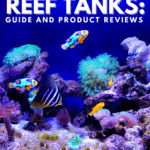When it comes to iconic set-ups, saltwater aquariums are the King of the Aquatic World. Starting a large marine or reef tank can be an expensive investment, however, and requires a lot of space and equipment. If you’re pressed for a room or would prefer to start on a smaller scale, then check out the best nano reef tanks instead!
Quick Comparisons of the 6 Best Nano Reef Tanks
| IMAGE | BRAND | DETAILS | |
|---|---|---|---|
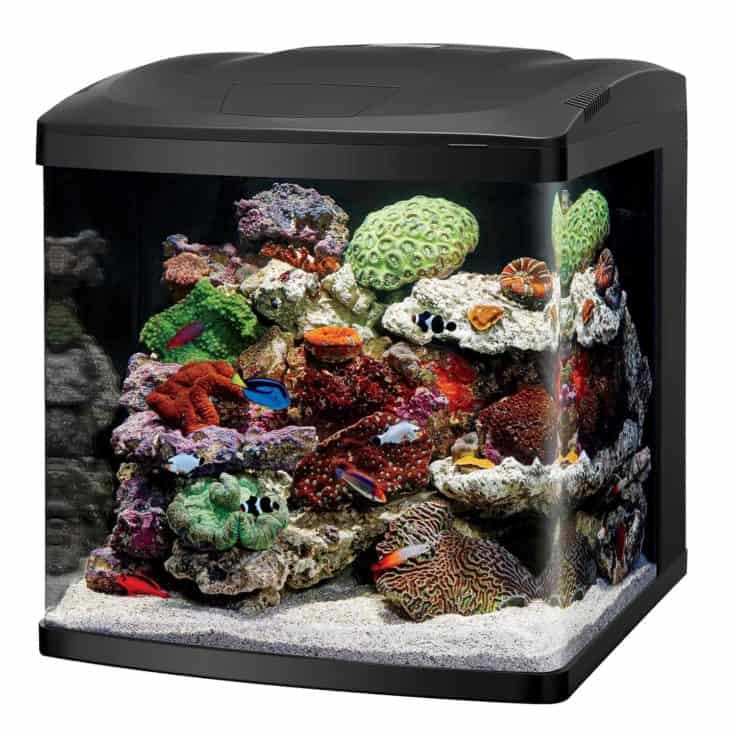 | Coralife LED BioCube |
| View Product |
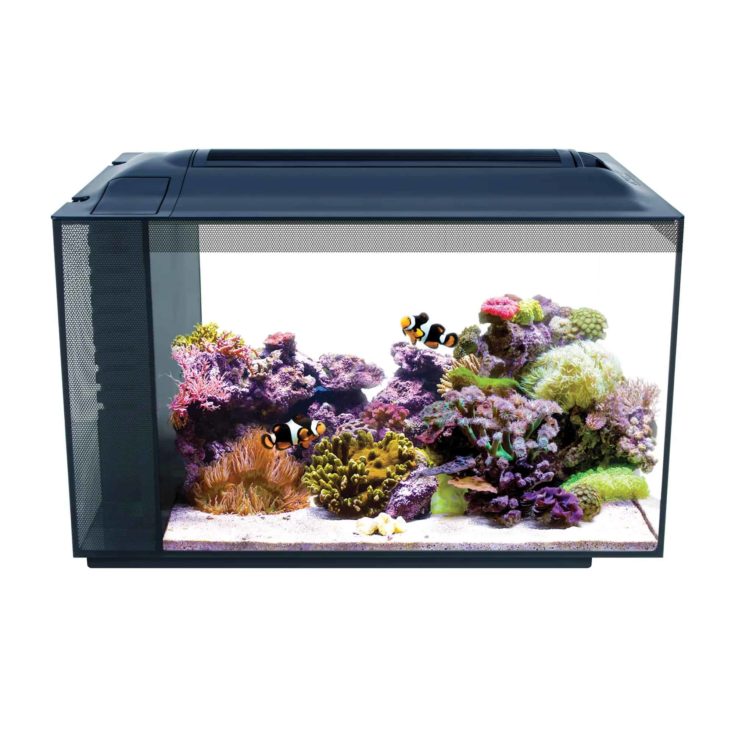 | Fluval Evo XII Marine Aquarium Kit |
| View Product |
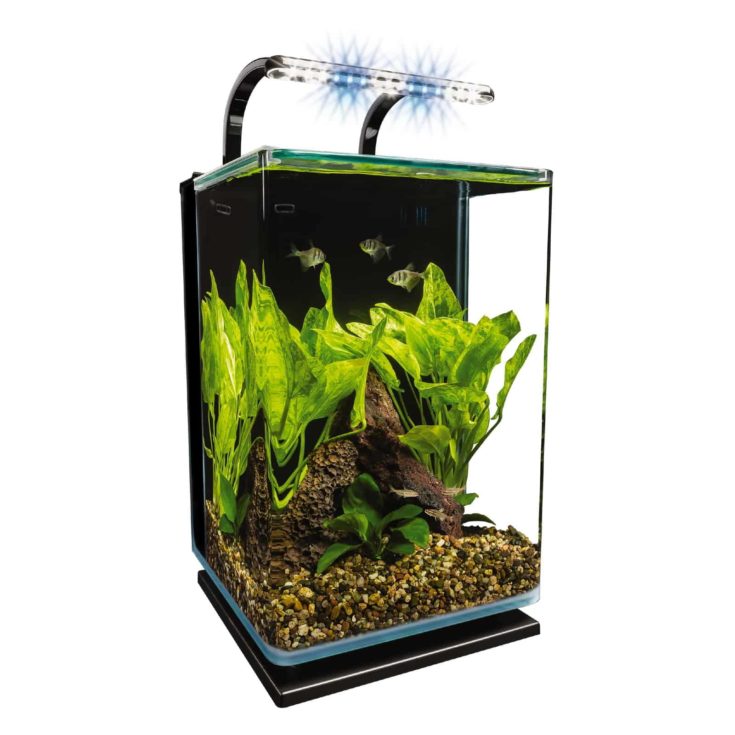 | Marineland Contour Aquarium Kit |
| View Product |
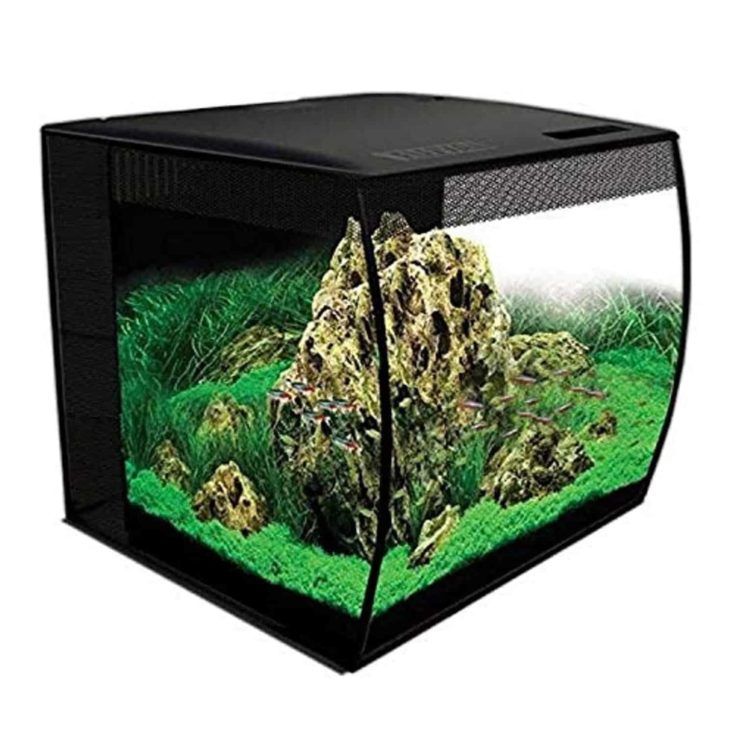 | Fluval Flex Aquarium Kit |
| View Product |
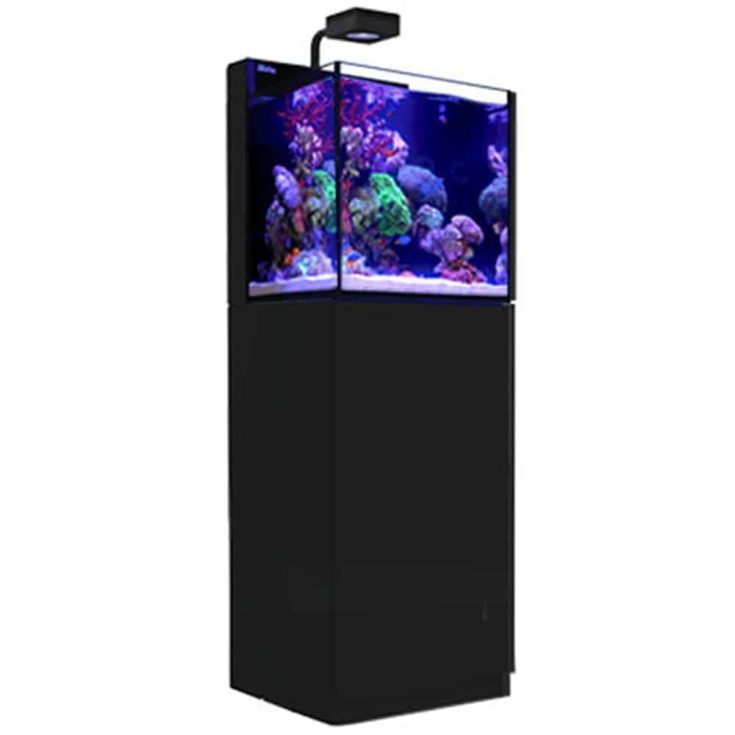 | Red Sea MAX NANO Rimless Aquarium |
| View Product |
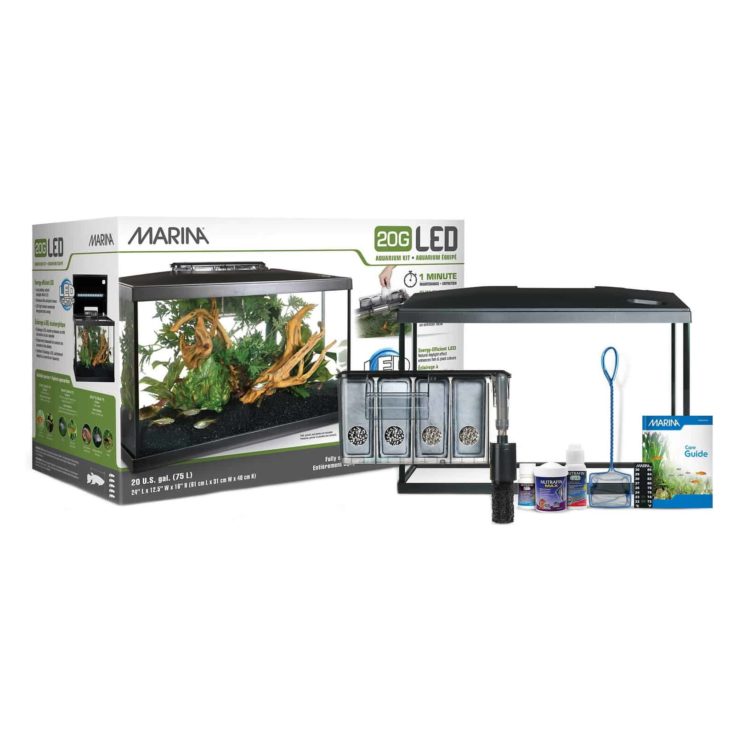 | Marineland LED Aquarium Kit |
| View Product |
Guide to Mini Reef Tanks
There was a time when it didn’t make sense to keep small marine aquariums, due to the immense start-up costs and the difficulties in finding saltwater specialized equipment for tiny tanks. Advancements in technology have solved those problems, and there’s never been a better time to start a miniature reef aquarium!
Nano tanks are not just suitable for Betta fish and other tiny freshwater species like tetras, snails and shrimp. Modern kits make things easy by selling small coral tanks along with the filtration and lighting systems you need to build a thriving ecosystem. Let’s take a look at what you can expect when searching for nano saltwater tanks.
What is a Nano Reef Tank, and How Does it Work?
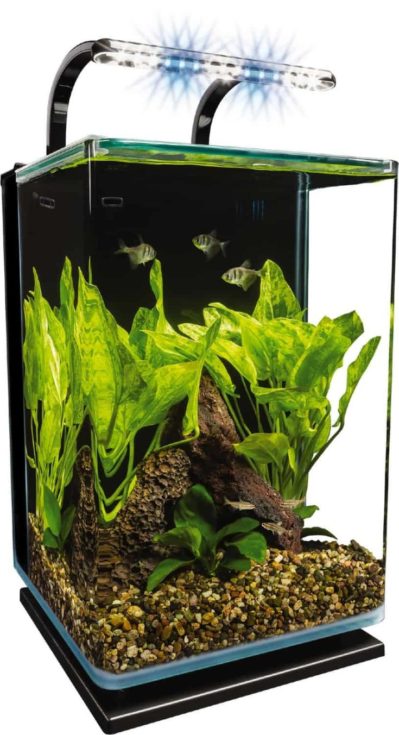
The exact definition of “nano” tanks varies around the world, and has become a bit of a buzz word in the last decade or so. So what are nano aquariums, and reef tanks specifically?
- In the US, nano typically refers to a tank with less than 30 gallons of water capacity.
- Nano usually describes a tank that’s small enough to sit on a table or bookshelf, as opposed to a set-up that requires its own special stand.
- A nano reef tank is simply a miniature saltwater tank focused on keeping corals, live rocks and sand, and perhaps some small reef fish as well.
You can buy a small aquarium and set up your nano reef system by sourcing each piece of equipment separately, but it’s often more cost-effective to get a kit. Then you can get your tank, filter, and lighting system all in one shot!
Types of Small Reef Tanks
There are two kinds of nano tanks you’ll usually see advertised as appropriate for marine environments. The primary difference between the types is their size and water capacity, which determines the type of marine animals you can keep in your tank.
Nano Reef Tanks
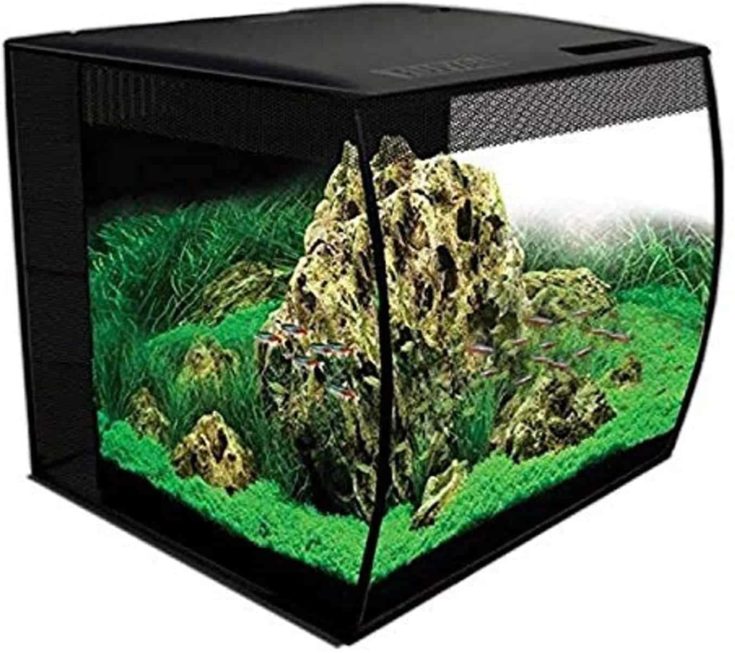
If you’d like the option of keeping saltwater fish along with corals and live rocks, then you’d probably be happier with a larger nano reef tank. Typically, nano reef tanks vary from 6 to 30 gallons in capacity and come in a wide variety of shapes and styles. This is the best size to start with if you’re new to saltwater aquariums.
Pico Reef Tanks
Pico reef tanks (or Picco, as they are sometimes called) are smaller than the nano tanks and usually clock in at 5-gallons or under. This makes them the ideal capacity for a desktop, bookshelf or bedroom tank, but also reduces the number and type of reef occupants you can keep in them. They are usually suitable for corals but not fish.
Benefits and Disadvantages of Small Aquatic Reef Set-Ups
There are several advantages of having a nano or pico reef tank over a full-sized 50-gallon or larger saltwater aquarium.

Their main advantage is they cost less to start-up and are easy to incorporate in almost any home or office. Large reef tanks usually require expensive and extensive set-ups including multiple external filters, aquarium sump filters and both internal and external lighting systems to highlight the full depth of the tank.
The primary disadvantage of small aquariums is that they are harder to maintain than larger systems because their water parameters and quality can shift very quickly. If you miss a water change in your tiny tank it could crash with little warning. You’ll also have a lot fewer options in the types of coral and fish you can keep.
Nano Tank
(6 to 30 gallons)
Benefits
- Ideal type for a starter tank or those new to saltwater aquariums
- Easier to maintain and less likely to suddenly crash than a smaller Pico tank
- Not as expensive to start up as a large saltwater tank
- Compact size makes it easy to incorporate into your home or relocate if you need to move it
- You can buy a Nano Tank Kit, or source equipment and design your own set-up
Appropriate Corals and Fish
Coral: Small, easy SPS, mushroom and soft coral frags on a base of live rocks and sand
Reef fish: Clowns, small varieties of Goby, Red Anglers, Firefish and small Wrasses like the Pygmy or BandedNot very attractive
Disadvantages
- Harder to maintain than in larger reef tanks and more likely to crash from ammonia spikes
- Daily to weekly water top-offs and changes required, along with close attention to overall water quality
- Smaller size limits the type and number of coral and reef fish you can stock
- Size constraints also limit your hardscape options, since you need to leave room for your fish and corals
Pico Tank
(5 gallons or less)
Benefits
- Ideal size and weight for a desktop, office or bookshelf reef tank
- Less expensive to start than a full-sized reef tank
- Easy to find kits that include a filter and lighting fixture
- Compact size and lighter weight makes it easy to move and relocate the tank any time you want
Appropriate Corals and Fish
Coral: Small, easy Zoanthids, mushroom and soft coral frags on a base of live rocks and sand
Reef Fish: Most marine fish unsuited to such small tanks, but you may have room for a small Goby
Disadvantages
- Hardest type of reef tank to maintain
- Daily to weekly water top-offs and changes required; close attention to salinity and water quality required to avoid ammonia spikes and crashes
- Not ideal for less-experienced saltwater fish keepers
- Harder to source high-quality multi-stage filters for Pico-sized tanks
- Extremely limited in the types of corals you can keep, and very few fish are suitable
What Features to Look For in Micro Reef Tanks
Once you’ve decided to start your nano reef aquarium, it’s time to talk about how to pick the best tank for your needs. There’s a few key factors to consider when choosing a nano or pico tank, including:
Should You Pick a Nano Reef Kit or Build Your Own Tank?
It’s a lot of fun to design an aquarium and pick out your own tank, filtration and lighting systems (more on these below), but it’s harder to do this for mini set-ups than for large marine tanks.
- There’s simply not as many options in high-quality equipment for micro tanks compared to their full-sized cousins.
- It may be challenging to find the equipment you like that also fits inside your tiny tank, especially custom or non-standard sized and shaped tanks.
- It can also be a lot more expensive to buy equipment piecemeal than going with a marine nano kit.
I recommend that novice reef keepers go with a nano reef kit instead of designing their own small tank, since they make the initial set-up easier and less stressful. Look for a kit with the size and shaped tank you prefer, and one that includes a multi-stage filtration system and robust coral-appropriate lighting.
Shape and Size of Nano Aquarium
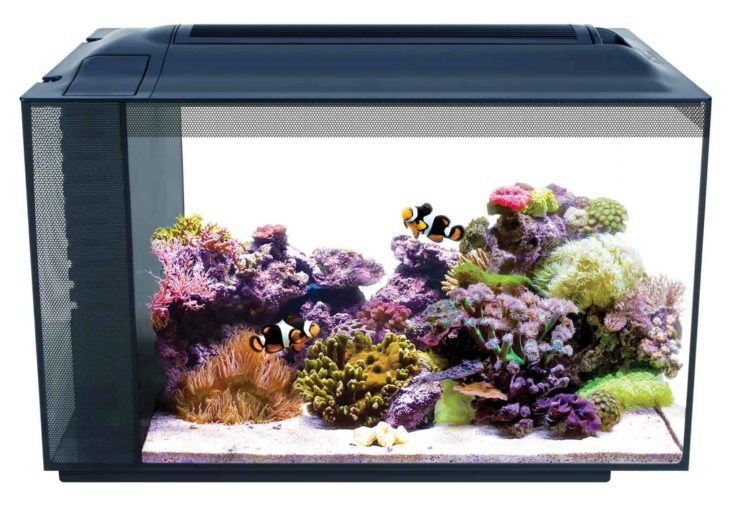
Both types of mini aquariums are available in a variety of shapes and styles, including bow and curved fronts, cornerless, rimless and cube-shaped reef tanks. You’ll likely find more options for nano tanks than the smaller pico types, though. Or you can opt for a standard, rectangular-shaped aquarium for your tiny reef.
The shape of your reef tank matters, because light doesn’t penetrate very far through the water. If you opt for a tall-style tank, you may be limited to keeping coral along the upper part of the aquarium where the light is ideal for photosynthesis. Shallow tanks may allow more room for corals, but are not as compact as cubes and bow fronts.
Filtration for Small Tanks
Reef tanks require really high-quality filtration systems because corals and many saltwater fish are very sensitive to their water quality. A small shift in your water parameters could easily cause a coral tank to crash, so don’t skimp on your filtration system.
- 3-stage filter with at least one stage of biofiltration and room to hold filter media is ideal for reef tanks.
- Aquarium sump filters are highly desirable for maintaining the water quality in coral tanks, so the very best marine nano tanks include a sump stage.
- Media such as carbon can neutralize toxins and clean the water, and bacteria in the biofilter and sump consumes ammonia and helps maintain stable water chemistry.
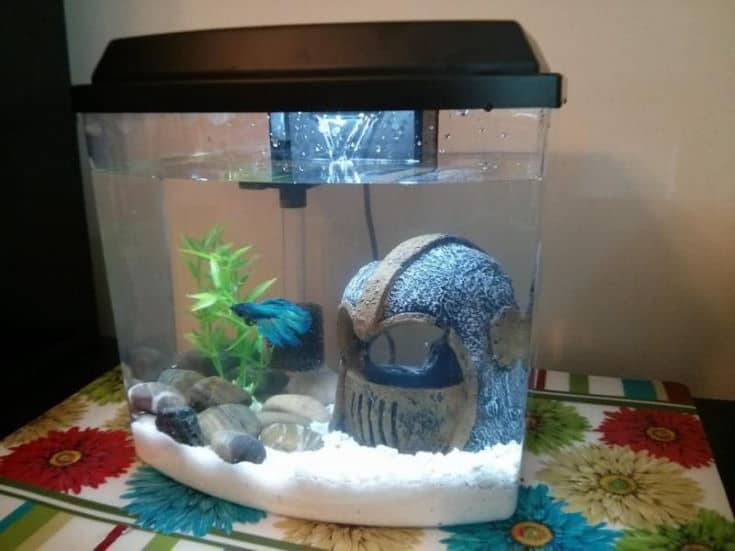
Your tank’s shape and style also impacts the type of filtration you can use with it. HOB-style filters, for instance, often don’t fit on rimless tanks. Nano reef kits usually come with a built-in filtration system you can modify, making them easier to deal with and more compact than a custom set-up.
Importance of Lighting in Reef Tanks
Corals are photosynthesizing organisms that require a very specific spectrum and intensity of light, and the ideal settings depend on the type of corals you’re keeping and how far they are from the light source.
I cover this in detail in my article on reef lighting, but the good news is that nano reef aquariums are so small it isn’t hard to find lights for them at a reasonable price. It’s also not difficult to find compact, reasonably priced LEDs to modify or upgrade your reef tank kit if the included fixture doesn’t make the cut.
Many compact LED lights produce the right spectrums for raising the easier types of soft and SPS (small polyp stony) corals, and most marine nano tank kits come with appropriate lights to support a basic reef environment. If you’re buying your light fixture separately, you’ll have to research the best system for your particular tank.
How to Set-Up a Reef Tank
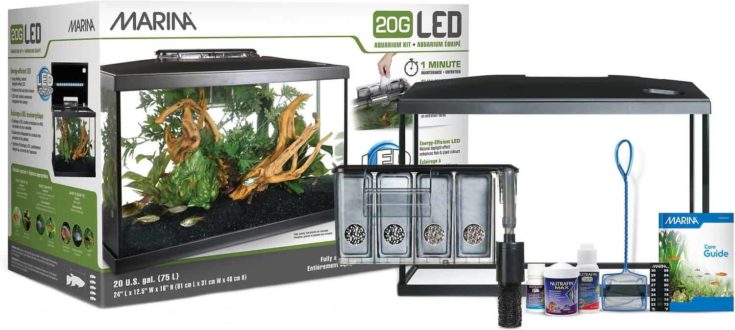
The initial set-up for a reef tank is similar to setting up a freshwater aquarium:
- Unpackage your equipment.
- Rinse your substrate with saltwater or use live sand packaged in saltwater, and place it in your tank.
- Set up your filter, heater and light system. Then you can fill your tank with saltwater and start cycling your new reef tank!
Cycling Your Reef Tank
You can add live rock to build the base of your reef while you cycle the tank, but you shouldn’t add any corals or fish for at least 3 to 6 weeks. It takes time to establish the good bacteria that devour ammonia, and your tank may have spikes and crashes as the nitrogen cycle is established. Limit your light levels to reduce algae growth.
Establish Your Maintenance Routines
You’ll have to top your tank off with water and check the pH and salinity at least several times a week and possibly as often as every day. Maintaining a saltwater aquarium is a lot more labor-intensive than most freshwater set-ups, so work out a good routine as you cycle your tank to make things easier once you add corals!
Adding Coral and Fish to a Reef Tank
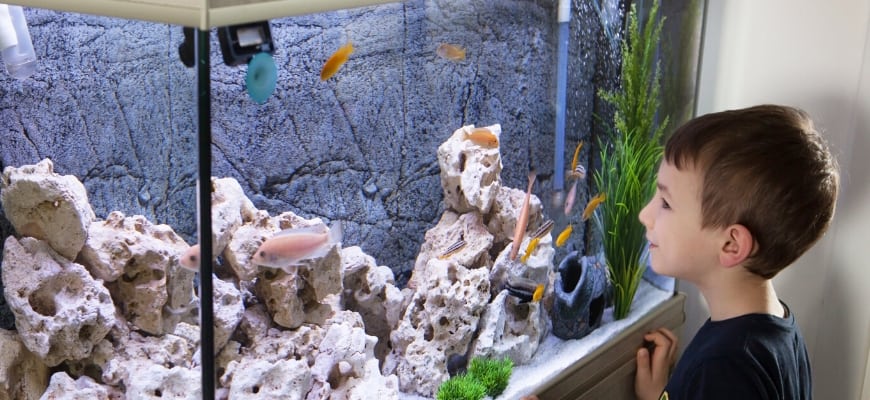
Once your tank is cycled and the pH, salinity and water hardness are stable, you can slowly start adding coral frags (fragments) and fish to your reef environment. Once you have a thriving population of animals in your tank, you’ll need to start regular water changes and adjust your day and night light cycles to maintain your corals.
Best Small Reef Aquariums: Nano Kit Reviews
Let’s take a look at the most popular nano and pico reef tank kits and see which are most suitable for your needs and budget. These are all excellent options for mini reef habitats and come with the basic equipment needed to start a coral tank. You can usually expect to get your tank, hood or cover, filter and lights in these kinds of kits.
Unlike aquarium starter kits, however, small reef kits don’t usually come with gravel or decorations. You’ll still have to choose the substrate, live rocks, corals and fish for your tank, and many aquarists also upgrade or customize their filters and/or light systems further once their tank has matured.
1. Coralife LED BioCube

- Capacity: 16 Gallons
- Dimensions: 17.5 x 16.5 x 15 inches
- Features: Glass tank, built-in hinged hood, LED light with automatic timer and actinic moonlight, compact internal filter with customizable chambers, submersible pump with dual intake nozzles
If you’re looking to start a mid-sized reef tank, the Coralife BioCube Kit could be the way to go. The square-shaped glass tank has curved corners for a better appearance and view, and the rear panel is clear to make adding a refugium (refuge for delicate species) easier. The filter has room to hold extra media and is customizable.
The built-in hood includes an LED light with a timer and actinic moonlight, so it’s perfect for keeping coral and other reef species. You’ll have to add a heater if you’re keeping tropical corals, though, and there isn’t room for an integrated sump filter. You’d probably have trouble adding protein skimmers to this tank as well.
This is a nice nano kit and is a great value overall. It isn’t the most durable kit, and you’ll have to replace the entire hood if the LEDs go out. But if you’d like to start a reef tank on a budget, this is an excellent option.
| PROS | CONS |
|---|---|
|
|
2. Fluval Evo XII Marine Aquarium Kit

- Capacity: 13.5 Gallons
- Dimensions: 23.4 x 13.5 x 15.6 inches
- Features: Glass tank, built-in hood, internal 3-stage filter with extra media compartments, integrated LED light with moonlight, submersible pump with adjustable nozzle
If you’d like something a bit smaller or would prefer a more extensive reef kit, then you should check out the Fluval Evo XII aquarium kit. This is my favorite pick for starter tanks and is one of the most attractive options for reef tanks under 20 gallons. I love how the honeycomb pattern hides the filter compartment and water line!
The Fluval Evo comes with a classically styled glass tank and includes a compact hood and LED lighting fixture. The high-output lights are ideal for raising corals and include an actinic moonlight setting. The rear compartment holds the filter stages and extra compartments for media like carbon.
My main quibble with this set-up is that the LED diodes don’t seem to be very durable and often need replacement, which can add up quickly. Still, this is a reasonably priced kit and a great option for a starter reef tank!
| PROS | CONS |
|---|---|
|
|
3. Marineland Contour Aquarium Kit

- Capacity: 3 Gallons
- Dimensions: 12.05 x 11.82 x 11.62 inches
- Features: Glass tank and cover, 3-stage filtration system, compact LED rail light with blue moonlight
If you’d like a pico-sized reef tank under 5 gallons for your desk or office, then the Marineland Contour is the best option on my list. The kit includes a glass tank with rounded corners and the attractive LED rail light highlights all areas of the tank. The 3-stage internal filter is built into your tank and is slightly customizable.
This tank has a very modern or Art Deco kind of style, and the clear top makes it easy to see in at any angle. I really like the look of this tiny tank, and it’s one of the least expensive on my list! There aren’t a lot of fancy extras, though, and it’s a bit too small to keep fish with your soft corals. It’s an ideal option for a pico coral tank.
| PROS | CONS |
|---|---|
|
|
4. Fluval Flex Aquarium Kit

- Capacity: 15 Gallons
- Dimensions: 16 x 15 x 15 inches
- Features: Curved glass tank, integrated hood, LED light with remote control, 3-stage internal filter, dual adjustable outtake nozzles
If you want the most attractive nano reef kit, then the Fluval Flex could be the pick for you! This modestly priced kit comes with a beautifully curved glass aquarium with an integrated and almost invisible hood.
The high quality LED light is ideal for keeping corals and can be adjusted via the remote control, and the built-in filter compartment also fits Fluval heaters and protein skimmers (not included). The rugged 3-stage internal filter is customizable and holds stages for mechanical, chemical, and biological media.
One thing to be aware of, however, is that the actual capacity of this aquarium is only about 10-gallons. The internal filter compartment holds additional water but reduces the amount of room in the main section for fish and corals. It’s very easy to overstock this tank accidentally, so use the 10-gallon capacity when picking your tank mates to avoid problems.
| PROS | CONS |
|---|---|
|
|
5. Red Sea MAX NANO Rimless Aquarium
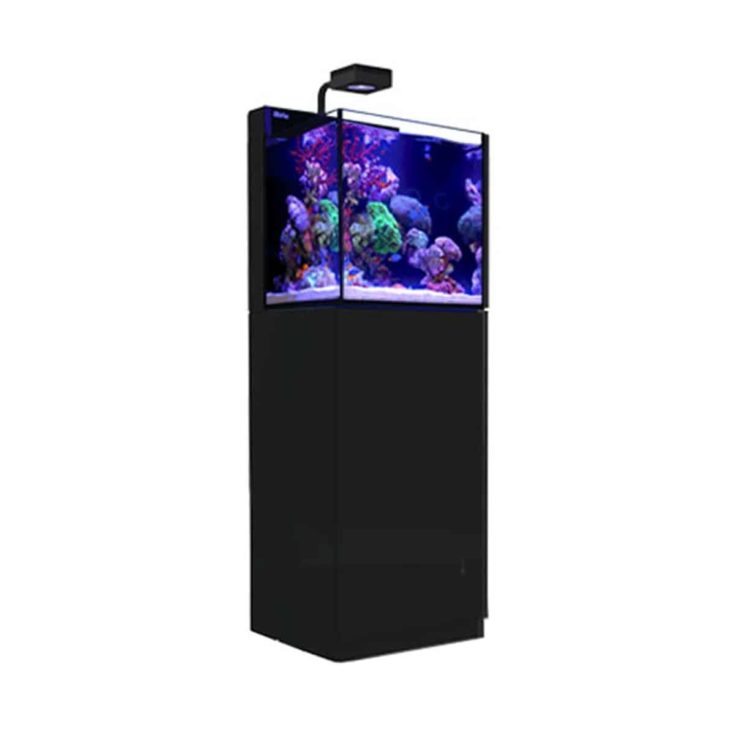
- Capacity: 20 Gallons total (16.5 Gallon Tank + 3.5 Gallon Sump)
- Dimensions: 18 x 18 x 18 inches
- Features: Glass cube tank, rear sump filter, surface and protein skimmers, 3-stage internal filter, advanced WiFi-enabled LED light with adjustable color channels, automatic water top-off system
If there is one tank on my that I can recommend wholeheartedly, it’s this premium aquarium kit from the Red Sea. The Max is a top-of-the-line kit that includes a sump filtration system connected to an automatic water top-off system, so your tank will always be at the right water level. This is a fully plug and play marine reef kit!
It’s so packed with features that I can’t even list them all here. The standout features are the sump, advanced and customizable filtration system, and extremely high-quality WiFi-enabled LED light system with adjustable color channels. This kit also comes with protein and surface skimmers as well.
The only thing this kit is missing is a water heater and a chiller unit for coldwater species, and those are not standard in reef tanks kits anyway. The primary downside to this tank is the price; it’s substantially more expensive than the other options. But if you’re serious about having the best nano reef you can possibly maintain, this is the kit to get!
| PROS | CONS |
|---|---|
|
|
6. Marineland LED Aquarium Kit

- Capacity: 20 Gallons
- Dimensions: 24 x 12 x 16.5 inches
- Features: Rectangular glass tank, hood with built-in LED light, clip-on HOB filter
20-gallon reef tanks are the ideal size for nano aquariums, and this basic kit from Marineland is a good place to start building your coral reef. For a very reasonable price, you’ll get a standard-sized glass tank with a hood and integrated LED fixture. The slim clip-on HOB uses replaceable cartridges and is easy to access.
This is just a basic set-up, however, and you’ll need to add an actinic moonlight if you want a thriving coral population. The filter does not have space for holding biological media, so adding a sump filter would be a very good idea and would stabilize your water chemistry too.
If you want an all-in-one kit, this might not be the best choice for you, but it’s a great way to save some money on a nano kit while still customizing your reef tank with extra add-ons. Personally, I’d ditch the clip-on filter and replace it with an external canister system and would add a sump filter for improved water quality.
| PROS | CONS |
|---|---|
|
|
Conclusion
If you’re looking to start a 30-gallon reef tank or smaller, then you should consider buying a nano or pico reef tank kit. Getting a kit is easier than buying the equipment a piece at a time, and you can be sure that the filter and lights will fit on your tank. Small marine tanks are harder to maintain than the big ones, however.
If you’re still not sure which tank kit is best for you, consider the following:
- The Red Sea Max is a premium reef kit and includes almost all the equipment you need to keep your corals and fish happy and healthy.
- If Max is over your budget, however, consider the Fluval Flex or Evo kits depending on the size and appearance you prefer.
- The BioCube is an excellent value, and the Marineland is a nice, basic set-up.
- For extra-small reef tanks, consider the pico-sized Contour.
